| Editor's Note: Hi, everyone. Incredible Sam here. I cannot stress how important this educational content is. If you read one thing, read this. I promise you — it’s worth it. This article is an absolute monster, however, so give yourself a solid 15 to 20 minutes to read through it and digest it. If you only have 60 seconds and want the TL;DR, click here. I was also a guest on a Shorr Solutions webinar for this topic on October 6th, 2022 - watch the recording here. Finally, I will be lecturing on this topic several times in the coming 12 months (GAC, ASAPS and others). My presentations for those events are recorded, and if you would like that as well… just message me. Stay safe everyone! |
Flashback… it’s late 2007.
The fluorescent lights of the conference feel especially bright at 7:04 am on a Thursday. It is my very first medical conference, and the session starts in precisely 26 minutes. I am grabbing some terrible drip coffee provided by the hotel, and actively avoiding the water, which I desperately need. Tucson is especially harsh on the survivability index.
I look down at my shiny iPhone, the first of its kind, fidgeting with it more than any human should, catching up on any messages I might have missed in the last 77 seconds. A deep and raspy voice asks inquisitively, “Is it all worth the hype?”
Finally, this is the moment I have been waiting for. Let me explain — in excruciating detail — how much superior this device (and me, by proxy) is than anything else, ever!
Yet, my excitement yields starkly to intimidation as I turned to the slim fellow who has moved into my personal bubble with no hesitation. The ribbons on his name badge were plentiful and oh-so colorful.
After noting the first five or six, I came to the last one: all black with gold lettering. PRESIDENT. My first conversation at any medical conference was about to be with the President of the Society.
“Yeah, it’s cool. It is a real game changer.” I respond, simply. At that moment, finding any more words was impossible.
“But poor timing, right? To launch in a recession — has to bite them in the ass.”
“Actually, the technology is unparalleled, it will change how humans interact, and doing so during a recession is the best thing they could do because Steve Jobs is an evil genius.”
These are words I never said. Instead, I nodded, and that interaction came to an unceremonious end.
Most of us lived through the Great Recession, which really hit America hardest in the spring of 2008. That recession acted exceptionally differently than almost all others in history, and quickly engulfed the world economy on the back of the housing crisis. The markers were not as rife with apparent signals, and there were fewer pundits sounding the alarms.
(Except that one guy, I guess — Yes, we all saw The Big Short.)

It was then, during the lowest point in the recession, that my friends and I decided to launch Incredible. I had learned so much during the previous year, about the medical industry, about how digital marketing works in healthcare, and about the severe lack of quality digital marketing agencies in the market.

“But why would you start a company right now?”
Not exactly a direct quote, but it was the not-so thinly veiled sentiment of virtually every family member and trusted advisor I turned to.
“Because iPhone… that’s why!”
Incredible signed its first client in May of 2008, and we never looked back. What a ride, and boy did we learn a lot about how to navigate a recession.
Is a Recession Imminent?
I have a love/love relationship with math. So much so, that for the longest time I believed I would follow that path as opposed to the one I am on today. Numbers are magical, they tell stories, but they are also precise and predictable.
A university professor of mine once told me “Human choice – it’s a real problem Sam. It messes everything up.”
While predicting individual decisions is maddeningly difficult for mathematicians, aggregated financial and economic downturns are much, much easier to factor. Much like any predictive mathematical formula, forecasting a change in our economy is merely calculating the right variables.
In the past 100 years, these markers have (almost always) been noticeable.
So, what are the elements of a traditional recession?
- A negative trend and decline in real GDP
- A negative trend and decline in real income
- A negative trend and decline in manufacturing (importing vs. exporting)
- A negative trend and decline in wholesale and retail sales of goods and services
- An increased trend and ascension in the unemployment rate
*data from the Corporate Finance Institute
Additionally, when inflation is out of control, and the government is forced to take aggressive countermeasures, this is a tell-tale sign of things to come.
The Fed just raised rates by three quarters of a point, and is intent on making that the “new norm” until inflation makes its way back to their target of 2%.
(Yeah, good luck with that.)
Now, not all of the factors that point to a recession are currently being met. But many of the factors above are heading in the wrong direction, and based on the cyclical nature of recessions, we are unavoidably due for a market “correction.”
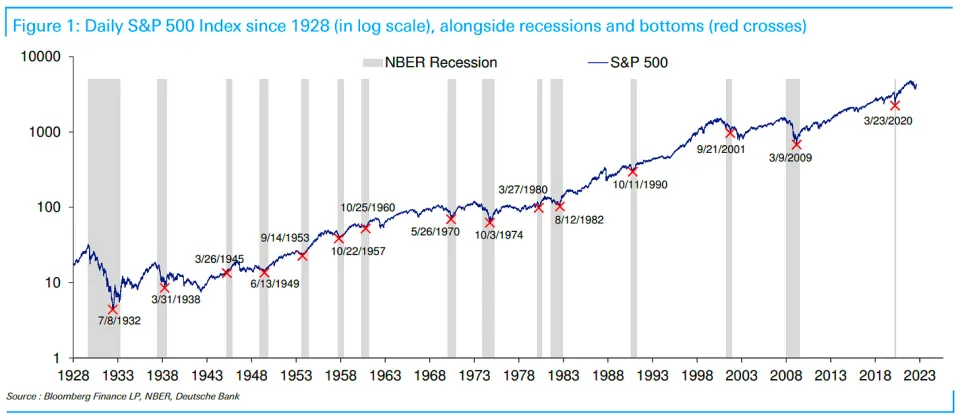
While it is true that you should not base your broad, sweeping economic forecasts on just my intuition, I would not be sounding the alarm if the data did not support this.
This has industry experts very, very concerned about the future. In fact, 3 out of 4 economists polled believe we are 16 to 24 months away from a significant recession.
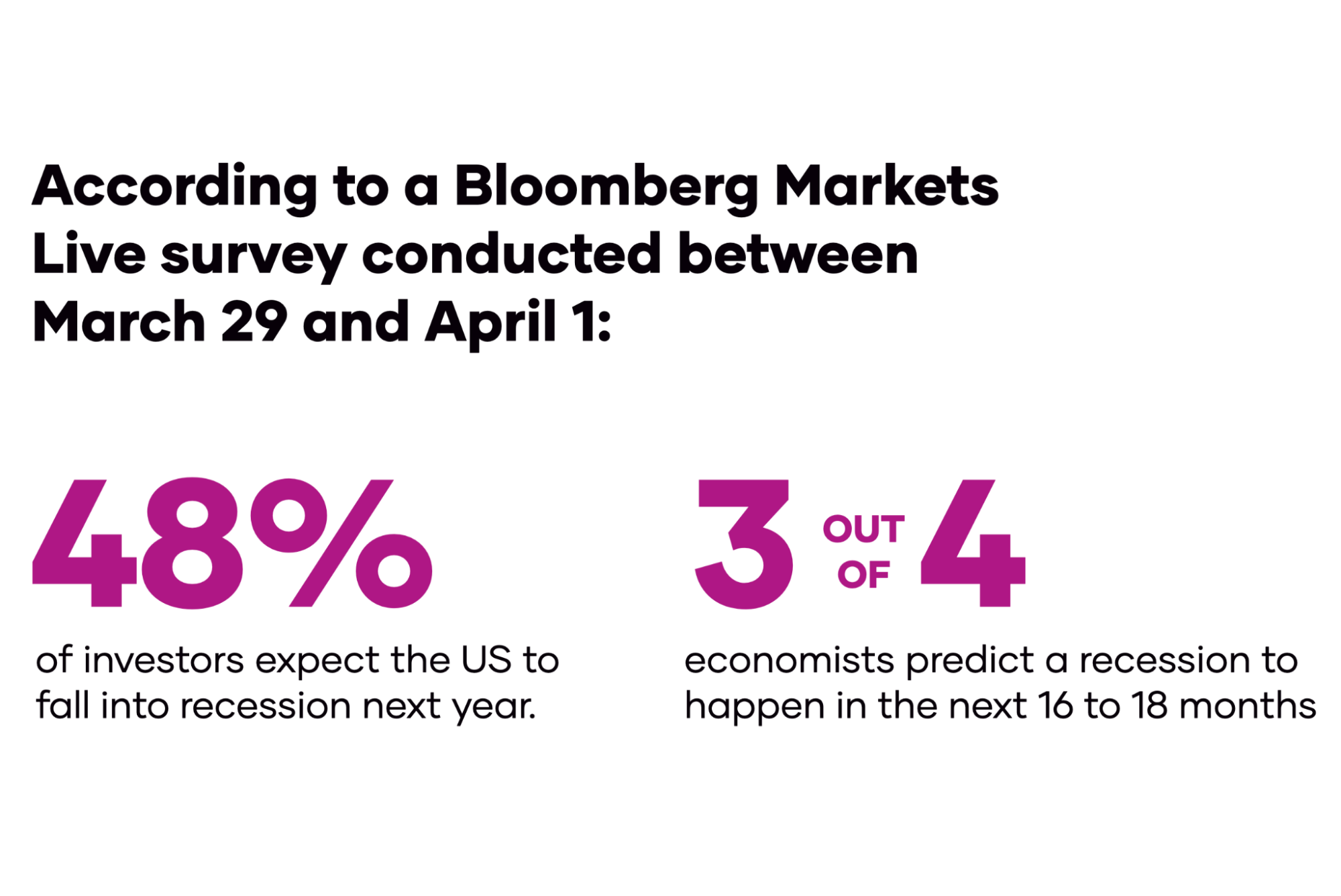
You do not need to be an expert mathematician or economist to understand why everyone is so nervous. Have you hired anyone lately? Tried to buy a house? Got your favorite poke bowl for lunch? Remodeled your kitchen? Prices are crazy, employment is crazy, and housing is crazy.
A $23 poke bowl is simply unsustainable. Something has to give.
So let me be absolutely clear – a recession is coming. But at least now, you have time to prepare.
Let’s get into it.
What Happens to Your Practice During a Recession?
The word itself — recession — is pretty scary for almost everyone, and it immediately causes us to go into “safety” mode. If you own a business, it means reducing expenses and cutting waste. If you are an employee, it means checking where you are on the seniority list and making sure you are as indispensable as possible. For those of us who aren’t Bill Gates, it means checking our bank accounts and putting away a few extra pennies in the rainy day fund.
Let’s be clear — in a recession, elective procedures go down. This we know as truth. In 2017, a meta analysis study published in the International Journal of Surgery examined the effects of an economic downturn on elective procedures.
To synopsize, most elective surgeries go down a lot, most nonsurgical cosmetic procedures go down a bit, but vasectomies go up. (Enter hilarious joke here). Also, Botox and lasers help keep the aesthetics industry afloat during the hardest times.
For doctors, and surgeons specifically — you have options. The study went on to find that many plastic surgeons supplemented their practice with reconstructive work or general surgery. Non-boarded cosmetic surgeons fell back into their previous specialty, and vein doctors did as well as their insurance reimbursements carried them.
So, I know “recession” causes a visceral reaction — but like my German mom used to say, “I don’t think you’ll miss a schnitzel.”

(Miss you, Mama — so much.)
The real question, however, is how this actually plays out for your practice. Typically, a recession just equates to fewer procedures and subsequently lower revenue. But that is the end result, and for us to be ready to weather the storm, we need to know the process. How do we end up there?
Disposable Income Dries Up
When the market really begins to shift, the amount of disposable income simply decreases. There is a much better analysis of this you can read here, but the short story is simple: there is less money available for everyone, and things that are not deemed necessities are purchased more infrequently.
You will begin to see reports of fewer people buying their favorite hand mixer on Amazon during Prime Day. The report about Black Friday will be dim. The holiday season will come and go, and the reports will begin to show that people are spending less.
Overall “New” Patients Begin to Decrease
When money is not in abundance, and the main factor in decision-making shifts from self-indulgence to fear, the overall pool of “new” patients begins to shrink. One of the most notable human characteristics is that when collective fear begins to surge, so too does risk-averse behavior. As a result, patients are less likely to try something new. A new procedure. A new practice. A new routine.
“Newness” is for the bold, and as we head deeper into a recession, courage becomes a commodity in short supply.
Patients Become More Price Sensitive
So disposable income has started to dry, and now your patient population is managing risk. The chance for them to engage in something “new” is exponentially decreasing. Thus, stage three inevitably occurs, and that patient who wouldn’t even ask the price of a procedure before is now asking to negotiate. This does not mean that your patients immediately become “cheap,” but the hunt for value becomes vitally important. During this time, you need to explain and elaborate on how you will provide value and do what your patient wants you to do. This is going to be critically important (more on this below).
Many providers actually take significant offense when this occurs. “She has been my patient for five years and has never questioned anything once. I have never done wrong by her, why would she do this now?”
Instead of taking this as a personal affront, you need to remember that you are not the center of their solar system. Doctors in particular tend to forget that they are not the leading actors in their patients’ lives. At best, you are a five minute cameo by Keanu Reeves. (Yes, you get to be Keanu Reeves.)
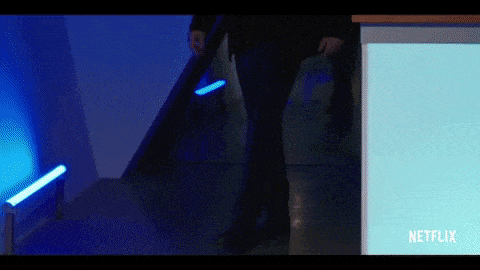
This negotiation process by your patients is not distrust, it is fear. I suggest you also read this article about the patient’s Hero Journey to better understand your role in that story.
Patients Reallocate Their Money
Lastly, patients are going to simply reallocate their money. This means they will shift from the things that are luxuries to the things that they deem necessary. Perhaps you have not seen Maslow’s updated Hierarchy of Human Needs, but neither Juvederm nor that blepharoplasty made it into the essentials list.
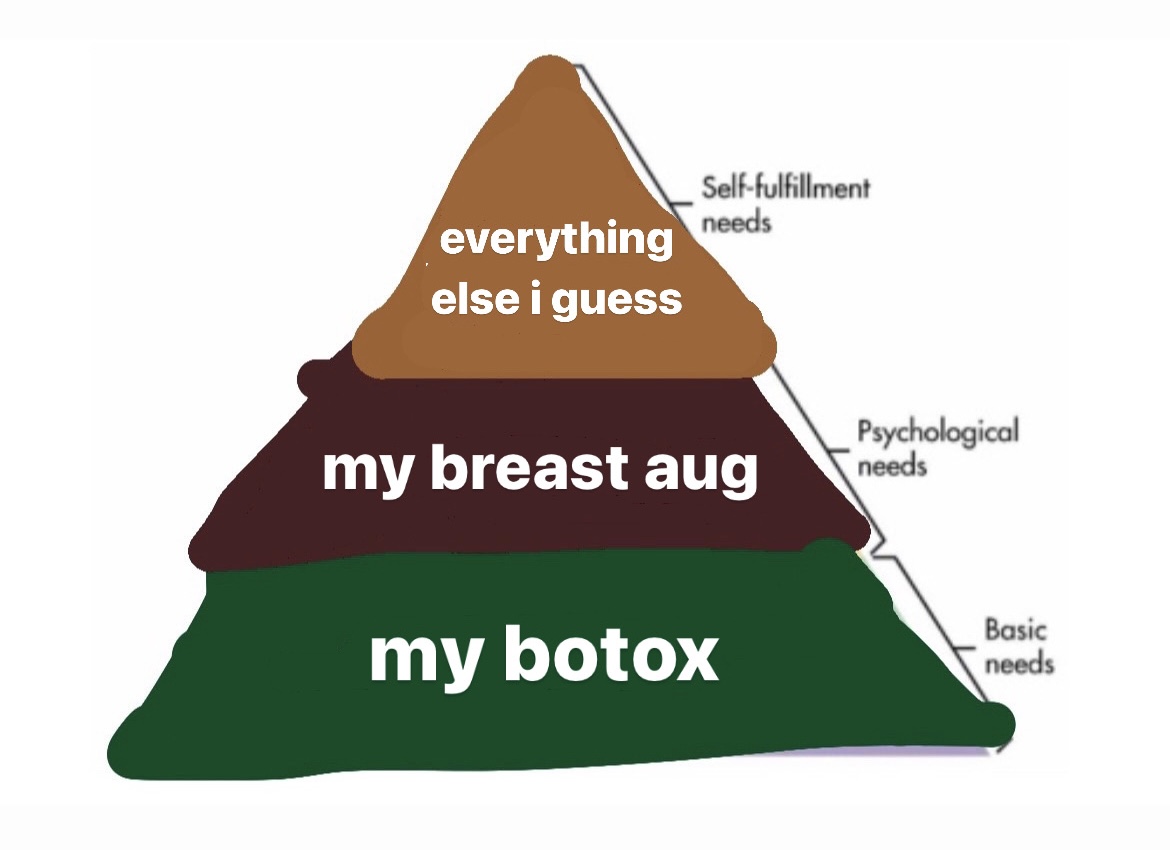
Botox and breast augs really defied the odds, though.
But please, let’s not get it twisted. In the world we live in, elective procedures will be seen as a necessity for many people, and this is not to say that all the money is reallocated away from the treatments you are providing. It simply means that the industry and you — yes, you specifically —need to do a better job of redefining what a necessity is.
This reallocation of their money is simply a move down the spectrum. As illustrated below, here is a fictitious example of a plastic surgery practice that is split evenly into surgical and nonsurgical procedures. (This is how we know it is fictitious.)
What you see is that in a strong economy there are more procedures, especially those on the higher edged tiers (full facelifts, Mommy Makeovers, full face laser, etc.). During a downturn, you see that there is a sharp reduction in new patients, and also that the overall volume of procedures on the higher end decreases, and those dollars shift towards lower tier procedures.
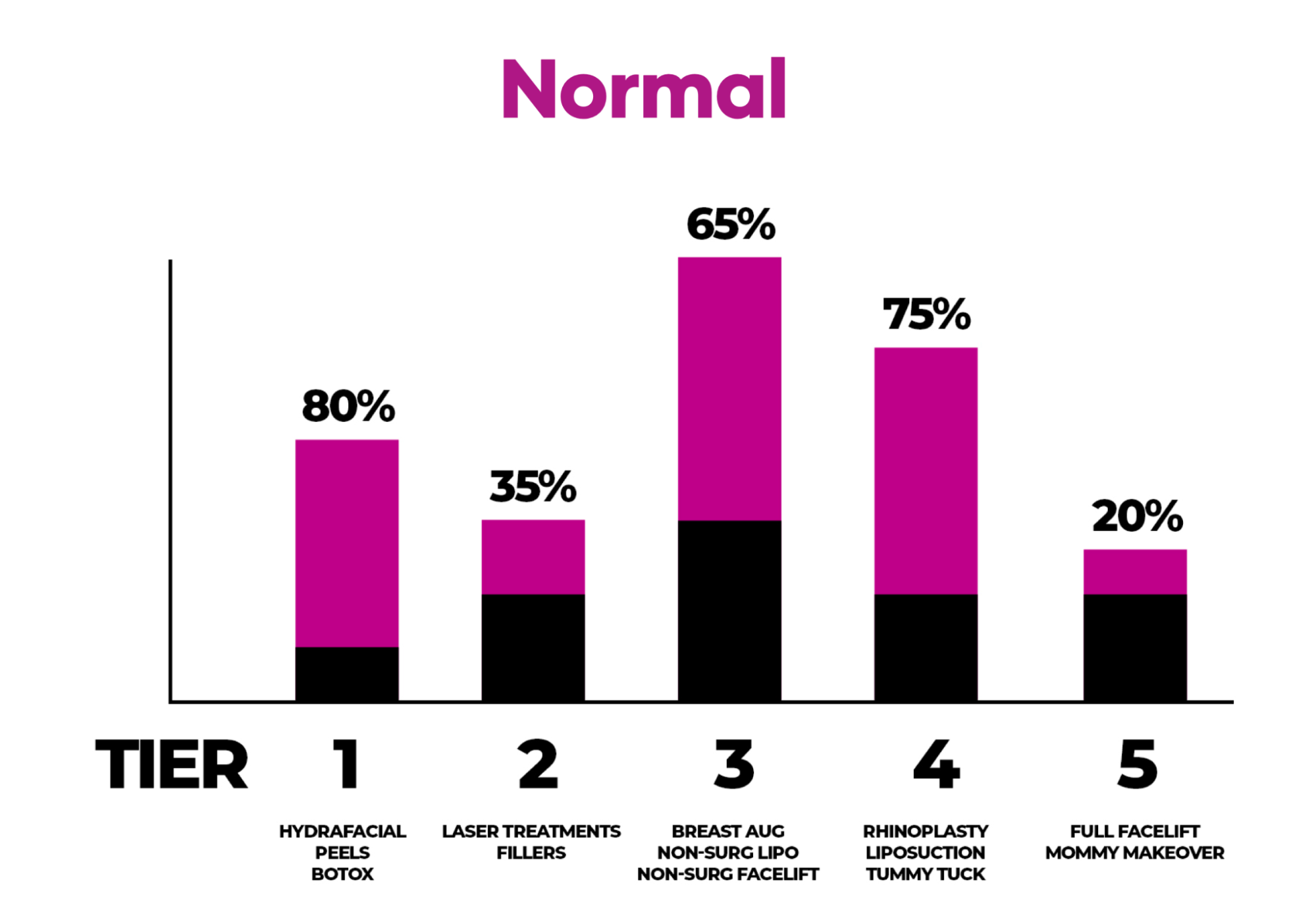
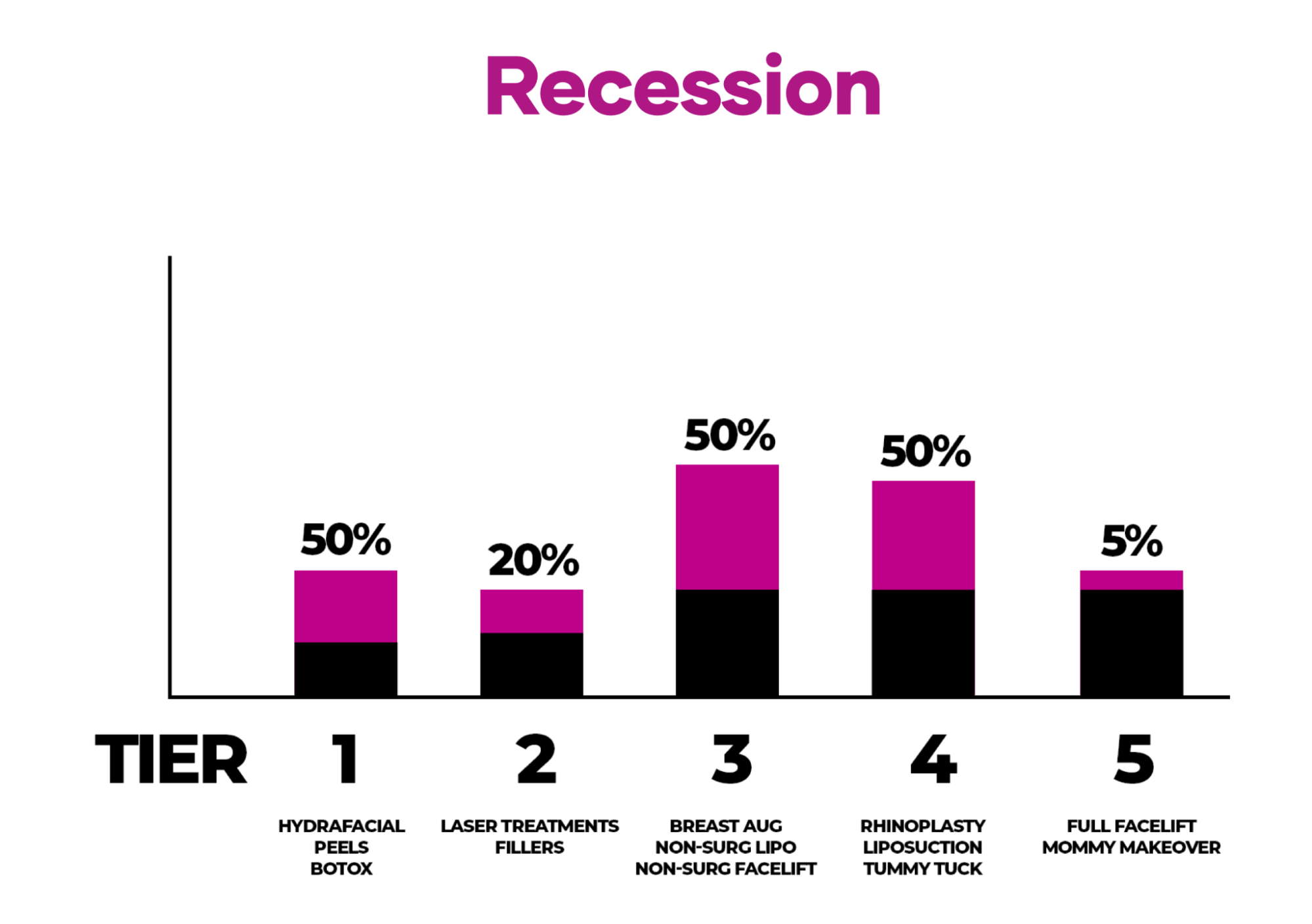
(This is an example only. Not a real practice.)
The Three Types of Doctors During a Recession
While working through the recession of 2008, into 2009, and slowly seeing the tide shift in 2010, I came across many doctors — and they were all looking for answers. What really surprised me was the range of emotions I witnessed. The undeniable frontrunner was simple defeat.
So many times I heard stories of downsizing, cut backs, and closings. Some even lamented having to return to big groups or hospitals.
But there were so many others. Apathy, bitterness, reflection, hopelessness, and acceptance. As time passed and the stories compounded, despair seemed to underlie every interaction I had. Then, over a drink (or three) at a Florida hotel, I ran into a new emotion, from a different type of doctor, which certainly caught me by surprise.
Pure, unabashed exuberance coupled with optimism.
(And they always smirked — why the smirk?)
99% of the overall personality types I came across fall into one of these three categories during a recession.
Doctor 1 – Dr. “It’s Too Late!”

This category of providers was definitely the majority. They numbered a solid 60% of the people I met, if not more. Their emotions were mostly in-check, but their vices were gripping them strongly as they fended off depression. The feeling of defeat was always present. Many felt blindsided, and the market was affecting them beyond just their immediate businesses. Many of them started taking side gigs at other clinics, and some even went back into rotation at the hospital.
The biggest thread that permeated this group was their overall feeling of helplessness and the inability to affect change. When it came to their business, their goal was merely to break even – taking a paycheck home was not their biggest concern. Expenses were being sharply trimmed, and most of the decisions were being made for the coming 30 to 90 days.
Just like their patients, they were risk-averse, spending less, and making decisions based out of fear. For them, it was too late for marketing to fix the next 90 days, but they had options. The issue was they were too paralyzed by fear to see past 90 days, resulting in nearsighted decisions.
Doctor 2 – “The Over Reactor”

The Over Reactor was the category of doctor that I found most baffling. The foresight had completely evaporated. So many smart, talented, and well-educated doctors seemed to abandon logic so quickly. All decisions were only being made out of emergency status, and a future of not being in a recession could simply not be imagined. The tell-tale signs were always the same. The Over Reactor cut every business expense. All procedures were heavily discounted. All marketing had stopped because they couldn’t “afford it,” and their decisions were not being fueled by fear, but instead by survival.
This group numbered around 35%.
But for almost everyone in this category, the survivability instinct was greatly exaggerated. No one was going to be living under a bridge. No one was unable to heat their homes, and certainly no one was missing a schnitzel. It was simply the idea of not being successful that was blinding their decision-making ability. That fear of failure caused their survival instincts to kick in, and long-term sagacity left the chat.
Unfortunately, just like someone who capsizes in the storm, and flails around in deep, dark, unfamiliar waters, their energy was wasted and used against them. Ultimately, their decisions did far more harm than good. While some did not make it, many did – but the damage had been done. The repercussions for this group were so severe that some did not recover until late into 2013 – and others, not at all.
These Over Reactors were also the ones to get taken advantage of at a higher percentage. Whether it was promises of a device fixing their practice (since it would take the world by storm), or an unscrupulous marketing company promising never-ending leads (because they knew, and only them, how to manipulate the Google algorithm), there were many dollars, pounds, pesos and euros spent in vain.
Doctor 3 – “The Evil Genius”

As I drank my nuts and berries (yes, that is a real drink, and it’s damn delicious) in this Orlando hotel bar, my conversation with the Evil Genius sitting across from me was so very different from all the others. “Pull back on marketing? Absolutely not, I want to be more aggressive – now is my time to capitalize,” he said without skipping a beat.
The reasoning “why” deserves an article to itself, but essentially, it was because he understood business. He understood market trends, and he was not making any decisions based out of fear. He continued to explain that during downturns in the economy, going all the way back before the Great Depression, those who used that opportunity to capitalize set themselves up for long-term success.
This Evil Genius was not making decisions for the next day, or 90, or even the next 365. He had a five-year business plan and he was executing.
Although we can debate whether a capitalistic society is good for humanity, what is most evident is simple – he treated his practice like a business, a marketing business, and he was the CEO. He knew what he was going to do, and what his opportunities would be. He still made decisions based in logic, and was more concerned with valuation than immediate cash flow – he was building his empire for the future.
This group of Evil Geniuses were few and far between, only accounting for less than 5% of all the doctors I encountered during the recession. But each and every one I came across shared the three exact same characteristics: they all chose to be aggressive, when everyone else chose conservatism; they never lost sight of the future; and they all had a plan, and stuck to it.
So, when this recession hits, which one of these archetypes will represent you?
OK, What Do I Actually Do to Prepare?
At this point, I can hear the exasperation running through your mind. “Just get to the point, Sam – for god’s sake, we are 2000 words in, and I don’t care about your nuts and berries or German schnitzels.”
That’s harsh – but fair. Let’s get after it. Do the following:
1. Market Your Ass Off – NOW

WAIT, STOP – don’t close the browser and stop your read here. I know what you are thinking, “Of course the marketing guy is telling me to market more. (eye roll)”
Yes, I get it – this sounds super self-serving, but I’m not saying to market with me.
Have a great agency already? Get it!
Your team is in-house? Yes! I love it.
Whatever your solution is – if it’s working, keep doing it, and do it HARD!
Here are the clear indicators for success that we learned through the last recession:
- Get new patients now and be aggressive! You have a window of opportunity before the recession kicks in to really ramp up your marketing, so cast a larger net and bring as many new patients into your ecosystem as possible. As we discussed previously, patients are unlikely to try new things or new practitioners during a recession. Now is your chance to bring in new patients and get them used to you and your practice. Even if the cost of acquisition is high, the availability of new patients is high, and if you have read up on the economics of the value of a patient, you know that their LTV (Life-Time Value) is so high that it makes sense to bring them in at almost any cost.
- No matter what, stay consistent. Out of all the practices we worked with during the last recession, 99% found success if they remained consistent. This is essentially stating in advance not to hit the panic button. Every single metric was objectively successful when a practice stuck to the marketing plan that was in place and when the goals were well defined. Almost every marketing campaign needs consistency to be truly successful, and this is built into almost every algorithm and process.
- Understand timelines and the patient funnel. Good marketing takes time. And Incredible Marketing, well, that takes even longer (for those of you who have built a website with us, you know). All jokes aside, nothing happens overnight in marketing. Most marketing campaigns have timelines and ramp-up periods. Has your SEO been failing to generate liposuction patients? It could take six months to a year to start seeing meaningful results (depending on your market). Even a solid paid ads campaign can take three months to go through the proper A/B testing and conversion analysis. But that is meaningless if your website is terrible. So build the best website you can, now, because that will take several months.
To top this all off, you have to add on the time it takes for a patient to commit to a consultation, and ultimately the time it takes for them to complete the procedure, depending on where they are in their decision funnel. Yes, someone looking for Botox will make a decision rather quickly, since that has become mainstream and commoditized, but it might take someone 18 months to decide on a full facelift.
The clock is counting down, and you need to be cognizant of this when setting real expectations with your agency, your staff, or your cousin’s best friend’s dog walker who also does your social media.
Pre-Recession Marketing FAQs
Q: How much should I be spending on marketing now? How much in a recession?
A: There is not one magic answer to this. But there sure is a range, and I go into detail about this when I lecture about the Economics of Digital Marketing (email me for that presentation deck). Essentially, follow the chart below – how much growth you want to achieve in 12 months (Y axis) versus how many years you have been in business (X axis). In a recession, you simply handicap yourself by a factor of one. (It’s like biking uphill, much harder to do, so if you want to grow by 10%, you have to spend like you are shooting for 20%.)
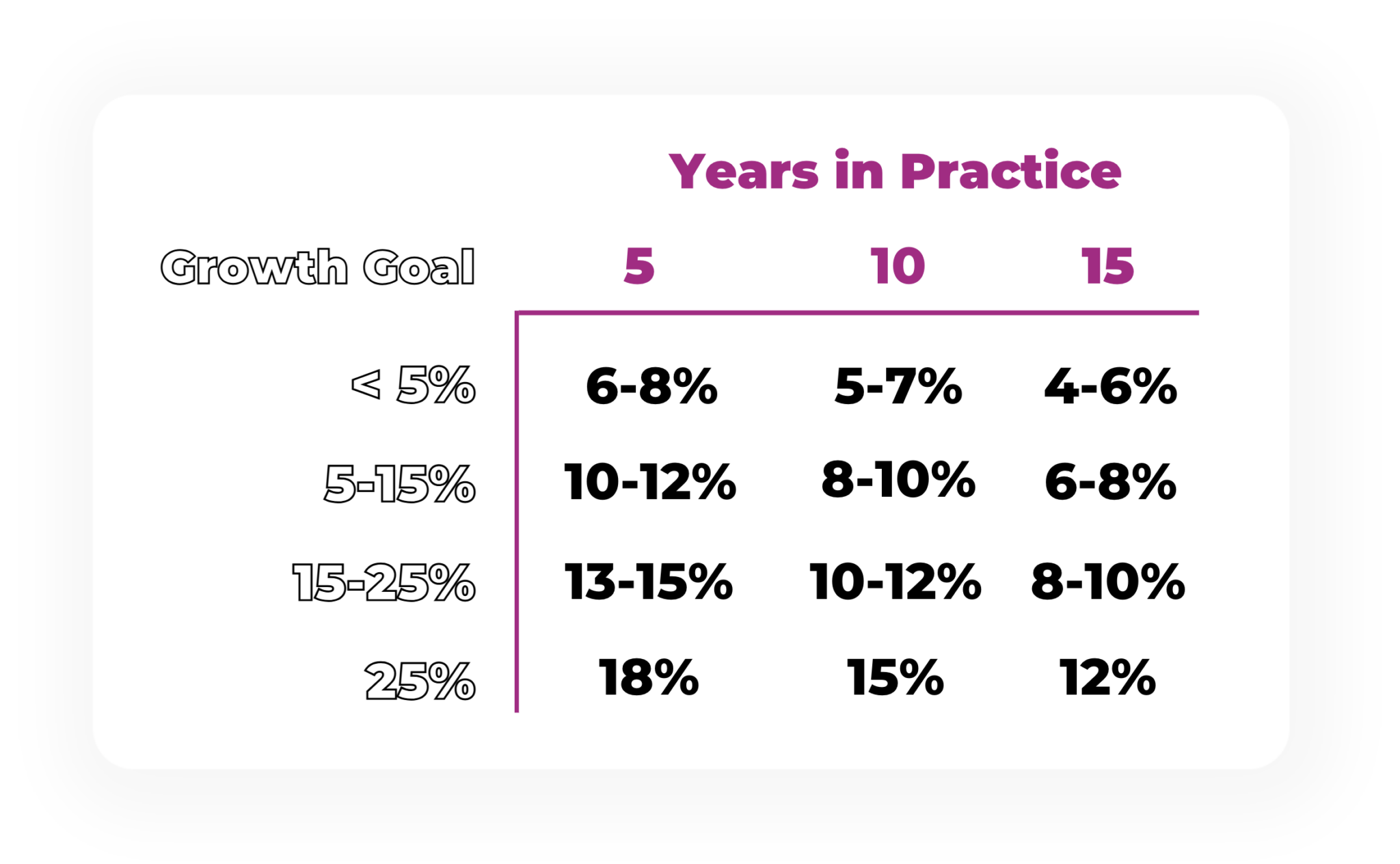
(This is a rough estimate of your spend, and can vary by market and types of procedures, etc. This includes hard and soft costs of marketing.)
Q: What type of marketing should I be focused on now? How about in a recession?
A: Right now, you want a broad-spectrum campaign that is attacking on multiple fronts and combining elements of both interruptive and permission marketing. When we start sliding further and further into the grips of the recession, you will pull back from the interruptive marketing campaigns.
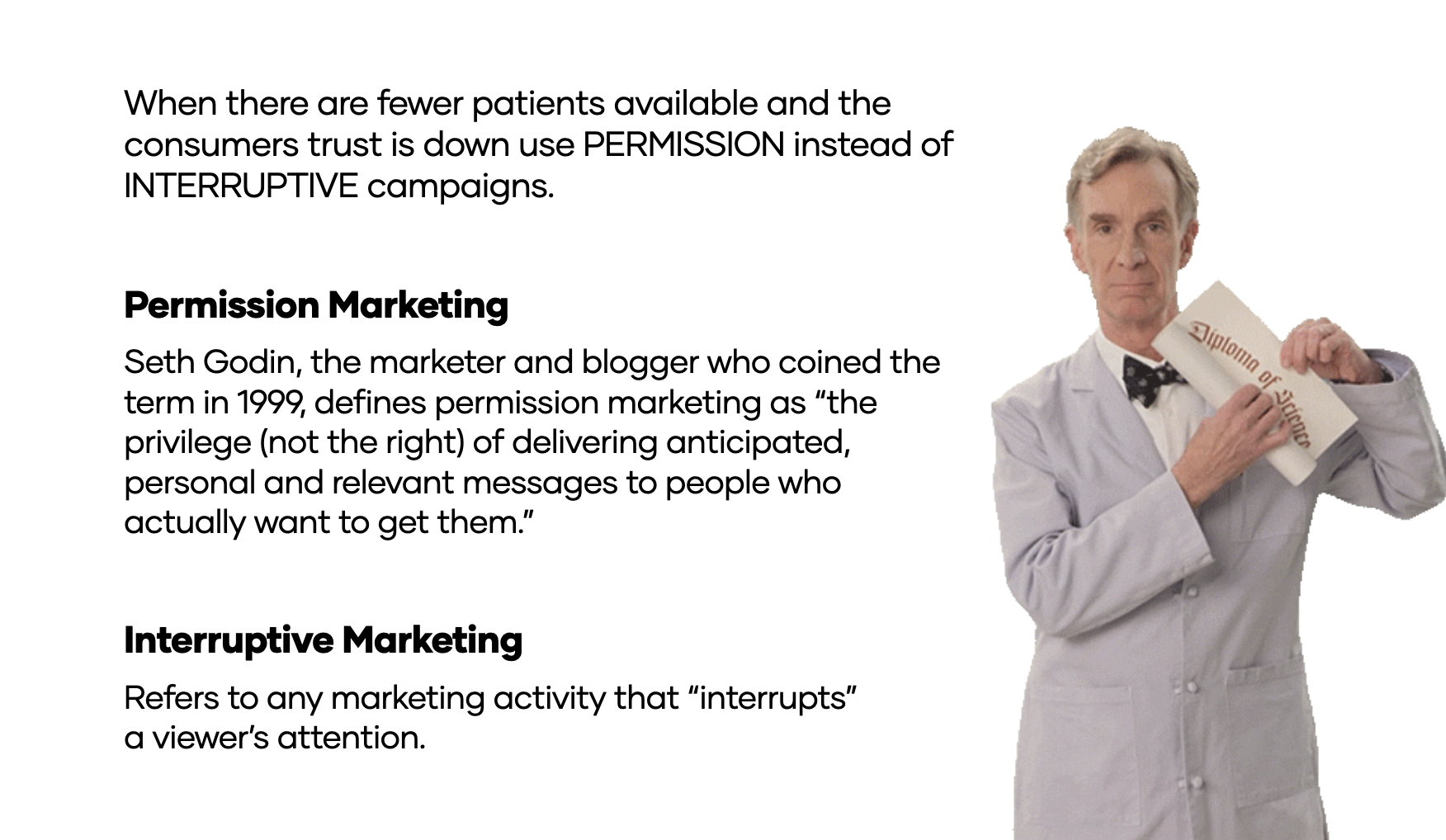
Q: What’s the most important thing to focus on right now?
A: Right now (and forever) you want to make sure your website is the best website you have ever put together. It needs to convert well, be well optimized, and get patients to grandma’s house (A.K.A., conversions). A poorly built website that converts below industry average can cost an aesthetic practice more than $450,000 each year.
(Yes, I did the math and researched the data, and look for my article coming soon called The Power of 1%).
2. Get Patient Buy-In
One of the things I learned during the 2008 recession was that we did not understand patients very well. This is especially true when it comes to understanding what made them tick and what they found to be important. Most importantly, we often did not understand the “why” behind their decision to choose a procedure or not. We have learned and are now more prepared to be proactive in this next recession.
When we discuss getting patients to buy in, it unfortunately is much more intricate than just giving each new patient a pep talk as they come through the door. (If things were only this easy.) What we mean here is that you need to change the mindset of your patient.
Sometimes that can happen with one large brush stroke within the practice, and unfortunately, other times, it is one by one. Some of this will challenge your resolve, and you will find this to be especially difficult right now because it requires the one commodity you lack most — time. You are busy now. Many of our practices are booked out four to eight months for nonsurgical treatments, and the surgical calendar is booked out four months or more.
If you want to prepare your practice, these are the steps you need to take while you still can.
- Create yearly plans. The most successful practices, regardless of the economic situation, are the ones that have a yearly plan for every single patient. Yes, this is highly dependent on this patient coming back for services and treatments, perhaps even skin care — so we are talking to the nonsurgical aesthetic group for this one.
Some practices will do this at the first consultation, but once the 12-month mark hits, they simply coast into “maintenance” mode. This is a costly mistake. By planning in advance, setting the course, and describing what will be done over 12 months, you get a patient’s buy-in. You get them to set the expectation and discuss what they want to accomplish. Every psychological review of human decision making backs up the notion that once heading down a specific course of action, your patient will be less likely to abandon it, even if changing the course is statistically in their best interests. - Institute subscription plans. 99% of the practices we have worked with historically do not offer subscriptions to their patients, and certainly no one did in 2008. But the subscription model is becoming more and more attractive. Every business is chasing that monthly recurring revenue (MRR). Truly, this is a benefit for everyone involved.
For example, say you have a yearly plan in place because you followed the point above, and that patient will get a variety of treatments and services over the next 12 months equaling $8,200. This has already been decided and agreed upon, but now how do they pay? If they are coming four times over the course of a year, a per-visit cost might be only $1,100 or as much as $4,000, depending on the procedures performed at that specific appointment. But what if they just had a monthly subscription amount of $700.00? Their likelihood of completion is much, much higher.
Many clinics already have their Botox clubs and some have concierge services that charge a monthly fee for premium access. Instead, this is a concept saying, “We will accomplish your desired outcome for a fixed amount per month.” Set this expectation now, and this will feel less burdensome to your patients in the future. - Implement a loyalty program. Different from either concept above, this is based on a bit of gamification. Allergan already does it with you via the Diamond status every clinic wants to attain. We all do it with Starbucks. (Yes, I have a problem – I am aware, thank you for your concern.) It is natural to want to be rewarded for loyalty and for spending money. There are a variety of these types of programs, such as: points-based systems; preferred status with benefits systems; and many others depending on the complexity of your practice.
Holding on to the great patients during a recession is the number one key to making it through a recession. Show them you care, and reward them. - Educate your patients: what is a necessity and what is a luxury? So, this is the one that will be hardest and most time consuming. This comes down to patient education and setting long-term expectations. You will need to have open and honest discussions with certain patients who will struggle through the recession about the difference between what they need and what they just want. As we discussed above, many patients will cut out the big spends and go into maintenance mode. It is up to you and your team (but mostly you) to define what that is.
Your patients need to know they can hold off on the CO2 laser treatment, but not their Botox or their varicose veins, or maybe their laser rosacea treatments. Defining this is critical NOW, so that when patients have to make the decision of “what” needs to be cut – they do not cut the entire aesthetic treatment services category. You want them to make the decision they make naturally and reallocate their money into other services.
3. Tell a Great Story
I think one of the things I spend most of my time doing these days is still convincing practices how valuable their content is, and ultimately, how much it matters. We are internet light years from 2008 when it comes to content and what your patients expect. Content can no longer be “passable.” It can’t even be just “good.” It really does need to be… wait for it… INCREDIBLE!
(Okay, I am done. I swear.)
Your content is an asset. From written word, to photos, to video – it’s all content. No matter the platform you use, it is all yours, and it is important. The Reel you post to Instagram – content! The about you section on your website – content! Your before and afters – content! (You get the idea). Yet all of these assets are often afterthoughts and never given the priority, time and importance they deserve.
Additionally, your content, in whichever format you choose, needs to tell a story. This is a far cry from what most practitioners have learned over the years. Medicine you understand — storytelling you usually do not. But these stories are vital and important. It helps the prospective patient understand you, the practice, and what lies ahead for them along their journey.
But Sam, how will great content help me during the proposed recession you see on the horizon?
What a fine question! Better content helps in (at least) 3 ways:
A) Improved Conversions
Look, at the end of the day – this is why we are here. This is why you are reading this ridiculously long article and what drives digital marketing success. When it comes to conversions, we want both – quality and quantity. Amazing content gives you both.
When it comes to the quality of the conversion, this one is pretty easy. A patient that digests great content, has their questions answered, and is able to connect with the practice before they ever walk through the door is not going to be looking for a reason why they should move forward – but instead, simply trying to see if there is any reason why they shouldn’t move forward.
On top of that, well-thought out content that expresses who you are and what you are about will naturally draw in the right type of potential patient. You know, a “birds of a feather flock together” type of thing. With great stories, patient journeys, engaging video and educational material, you will attract the type of quality patient that connects best with you and your practice.
Now onto the great part – engaging content simply leads to more conversions as well. Digital marketers track your overall “conversion rate,” which is a percentage of your overall traffic that (you guessed it) converts. It has been shown, over, and over, and over again, that the best content leads to significant increases in the conversion rate.
At Incredible, for our elective services clients (especially in the aesthetics market), quality content can lead to a 1 – 2% increase in conversions across the board. That may not sound like much, but again, I have done the math, and we are looking at yearly improvements far into the six-figure range.
(For a full breakdown on the economics of digital marketing, stay tuned, I’m bringing all the math receipts to an equally egregiously long article that will be hitting your emails before the end of the year.)
B) Just… Better SEO
Content is still king. If content played football, content is playing quarterback, wearing number 12, has a charming style, and is married to a supermodel.

If content played basketball… (OK, I’ll stop).
But you get it, content is the GOAT. If your written content is great, the Google Overlords will improve your rankings. If your videos are engaging, the Google Overlords will improve your rankings. Do your images captivate your patients as they scroll through your before and after gallery? Yup, Google Overlords approve.
Content is still the most important factor in overall optimization. Better content, better rankings… and better rankings lead to better traffic. We then find ourselves looking up at more quality and quantity. (If there was only a cool infographic that conveyed this visually.)

(Boom!)
C) Improved Brand Loyalty
The last point to remember, and something we talked about up above, is brand loyalty. As mentioned previously, patients are less likely to change course during a recession. Great content helps keep your existing patient base loyal and connected, and can even ambassadorize them. (I know it’s not technically a word — deal with it).
Using social media, email marketing, and in-office communication platforms that connect with your patient base on a truly visceral level will help them stay brand loyal through the darkest of times.
4. Defining the Right Target Audience
When the economic market is strong, your practice is rife with new patients, and your tax advisor is whispering sweet nothings in your ears about tax shelters in the Cook Islands. But when it comes to marketing, you get experimental like an 18 year old accepted to UCSB with an undeclared major. This means you are trying out all different kinds of marketing concepts, ideas, and channels, and most importantly, expanding your practice to serve a wider variety of patients. More simply put – you try new and different nets to catch new types of fish.
As we eye the storm brewing in the distance, you need to bring that net in now Santiago, and target the patient persona that is going to sustain your practice when you are being rocked by the wind, rain, and unrelenting waves. The 80/20 rule is super important here, and we need to start targeting correctly ASAP.

Your practice is unique, and trying to define what that perfect patient persona looks like for you would be an exercise in futility. That being said, based on industry trends, market demographics, and the experiences we saw in 2008, here are some qualities and characteristics you may want to target.
- Patients who are looking for high-end services now. Those who have this level of disposable income now will typically be less affected through the long run, and they are already aware of the aesthetics lifestyle.
- Avoid patients who are searching for uber-popular / trendy procedures. This patient psychology typically has a different set of goals and mindset when it comes to aesthetics. They are motivated by wanting to look a “certain way,” which is fleeting and situational. Juxtapose that with the patient who wants to look more rejuvenated, healthier, younger, etc.
- Single women over 35, and married women without children will typically be less affected by economic stressors. No shade here everyone, just the data. (And yes, targeting is so good these days that we can effectively go after these exact groups.)
- Target niche groups. This can be a type of patient, an ethnicity or an age, coupled with a specific procedure, but your ability to be sniper precise with one target niche demographic will help you keep your calendar full.
It’s All About Strategy
Ok, let me clue you in on a little secret – it really all starts with strategy. Shocking! How many inspirational quotes have we seen where the gist is something to the effect of “No one ever plans to fail, but you probably will”? I am not great with quotes, but that is usually how it goes. The unfortunate part about these cheesy, cliche quips? Usually, they are true.
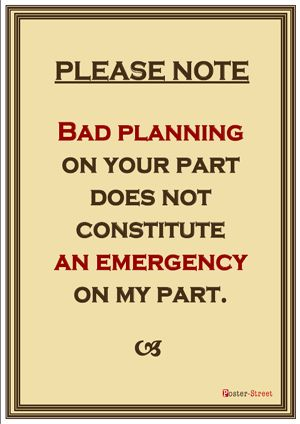
This section alone justifies an article unto itself, but for the sake of this piece, the takeaway is that you need to be militarily strategic with your planning. Tackle goals, budgeting and KPIs for 2023. Include all the key lessons above, and implement them as if the countdown timer is on, because it is.
That is, however, not all you must strategize. You need to put in what I call your “Delta” Plan. Which is the backup plan for when things start to go sideways. What does that look like, and what are you actually going to do when this happens? If you are unaware of the levers you will need to pull, you will be as unprepared for this as you were six hours ago when you started reading this article. Making decisions now, while you are logical, will allow you to avoid being the Over Reactor.
You don’t want that to be you – do you?
What Happens Next?
If you made it this far, I hope you are following what the tea leaves are saying.
Unfortunately – 97.2% of you won’t take action. The super majority of you will not immediately start to plan and buck the trend just because some smart assed digital marketer told you to.
So for those of you, here are the steps I would take when you look back at this article when your leads start drying up and your phone is deader than a…ummm… thing that is dead. (Crisis averted, I was so close to making a British monarch joke.)
1. Don’t compete on price.
We have written about this, talked about this, lectured about this, and tried to educate doctors around the world on this one topic. In fact, I would argue, when things get tight, you may even consider raising your prices. GASP! (But that’s a topic for 16 months from now.) Competing on price is merely a race to the bottom, no one wins, and it devalues you, your brand and your practice longevity. There are so many other ways to fight a recession – this is NEVER the answer.
2. Remember, there are no quick fixes.
When you find yourself starting to panic because of less patient volume based on prior poor planning, remember to not fall victim to anyone who can promise you an immediate fix. There are no shortcuts, backdoors, or work arounds. Time, dedication, and a plan – these are the keys to success. (OMG, I am starting to sound like an instagram fitness influencer, ughh)
3. Do not buy devices to solve your recession blues.
With all due respect to all the great machines out there on the market and those that are coming, a device will not save you from your practice’s problems, much like having a baby will not save that marriage you both know is over. The best devices can come with some marketing help and can complement a practice tremendously – but only if you are ready for it and can handle it. It needs to make sense. If you plan to buy a device in the next 24 months, I strongly encourage you to read this series we just put out.
CONCLUSION
If you are reading this in January 2024, I’m sorry. I really do wish you had been here when this first was published. The pie has shrunk, and marketing is now more important than ever. Scarcity and FOMO drive you to frantically do the marketing you should have been doing when the waters were calm and the fish were jumping into your boat without even the need for a net.
And if you do stand up, pay attention, and make your practice ready to weather any storm, then the evil genius in you will be admired (and envied) by all those who weren’t prepared.
See, Apple was never a tech company with great marketing. They are a marketing company, with great tech. And a marketing company does well in a recessive economy. Incredible launched in 2008 as a marketing company, with great digital marketing solutions. That’s how we took over – we saw the opportunity, just like Apple.
So don’t be a practice with good marketing – be a marketing company, with the best medical procedures around.
And when your colleagues bemoan the recession that has engulfed their practice, and ask why you aren’t sharing in their panic, you can give them a smirk, sip on that glass of whiskey, and say:
“Because iPhone… that’s why!”
…you beautiful evil genius you.
TL;DR
A recession is coming. The signs are here, and when this happens, new patients go down and overall procedures go down. There are things you can do to thrive instead of struggle. This includes marketing, changing the mindset of your patients, creating great content, choosing the right patient personas, and actually being proactive with a strategy. Most of you won’t do this in advance, however, so when it’s too late, don’t compete on price, believe in quick fixes, or think a device will solve all your woes. Be more like Apple, and seize the moment when others panic.
But seriously, come back and read this article.
I am sure that this knowledge and information has blown your socks off, and if you want to work together now, I honestly cannot blame you. Fill out a form here, or give us a call at (800) 949-0133 and let’s start the dance to make you Incredible.
(Maybe you have some questions, and you just want to pick my brain? Cool, let’s do it. It will cost you a cup of coffee, or a cocktail of my choice.)




